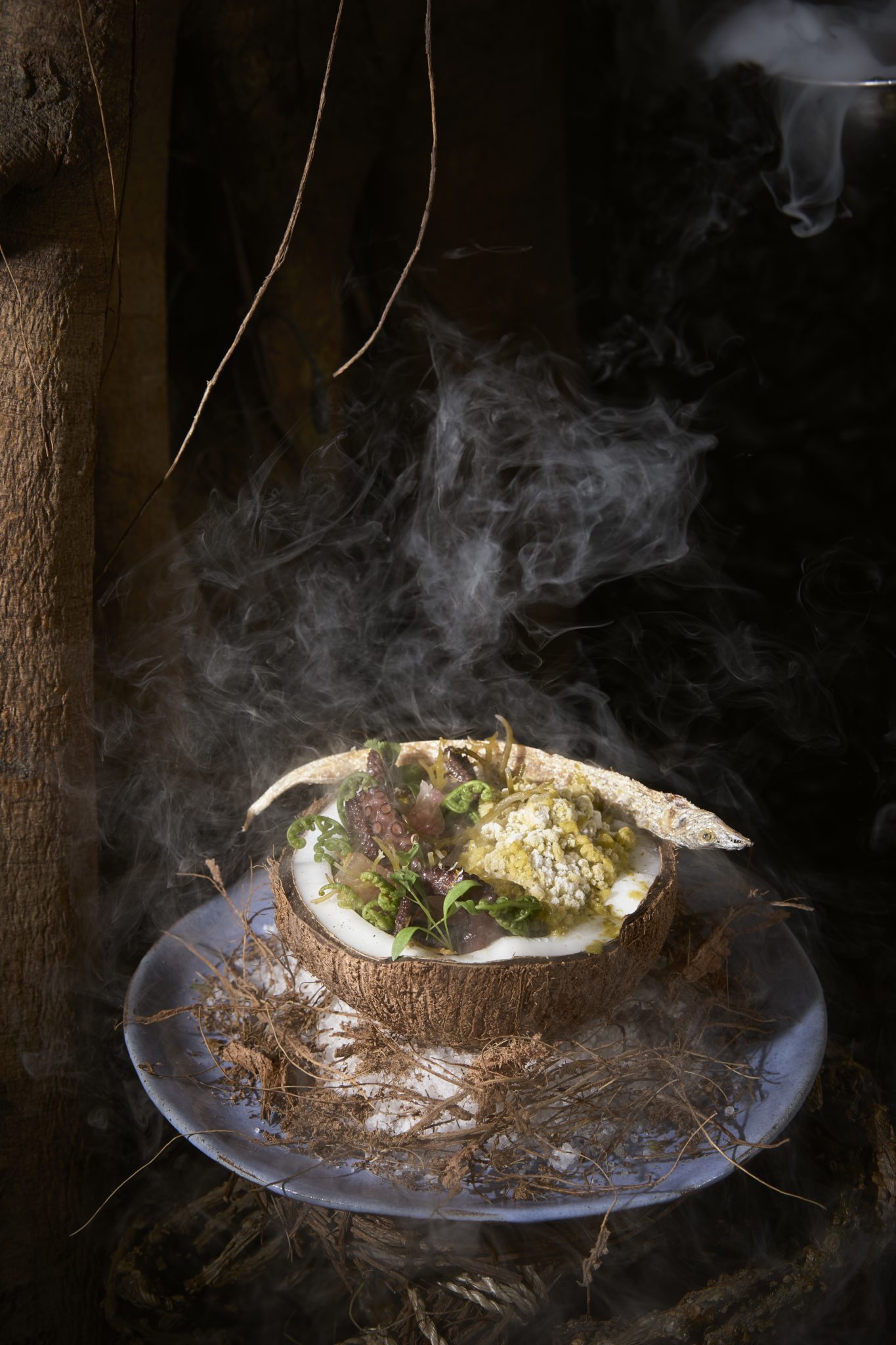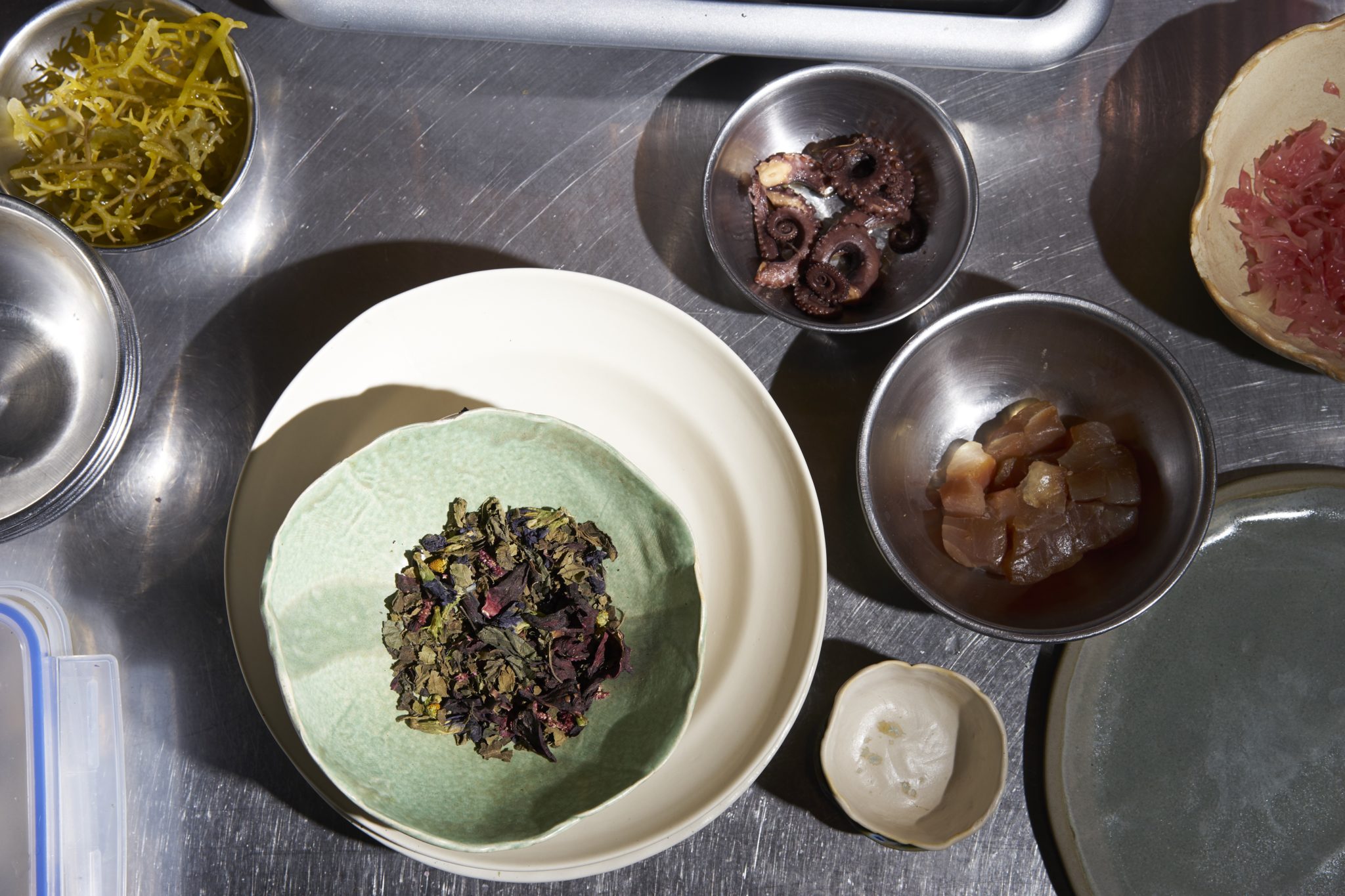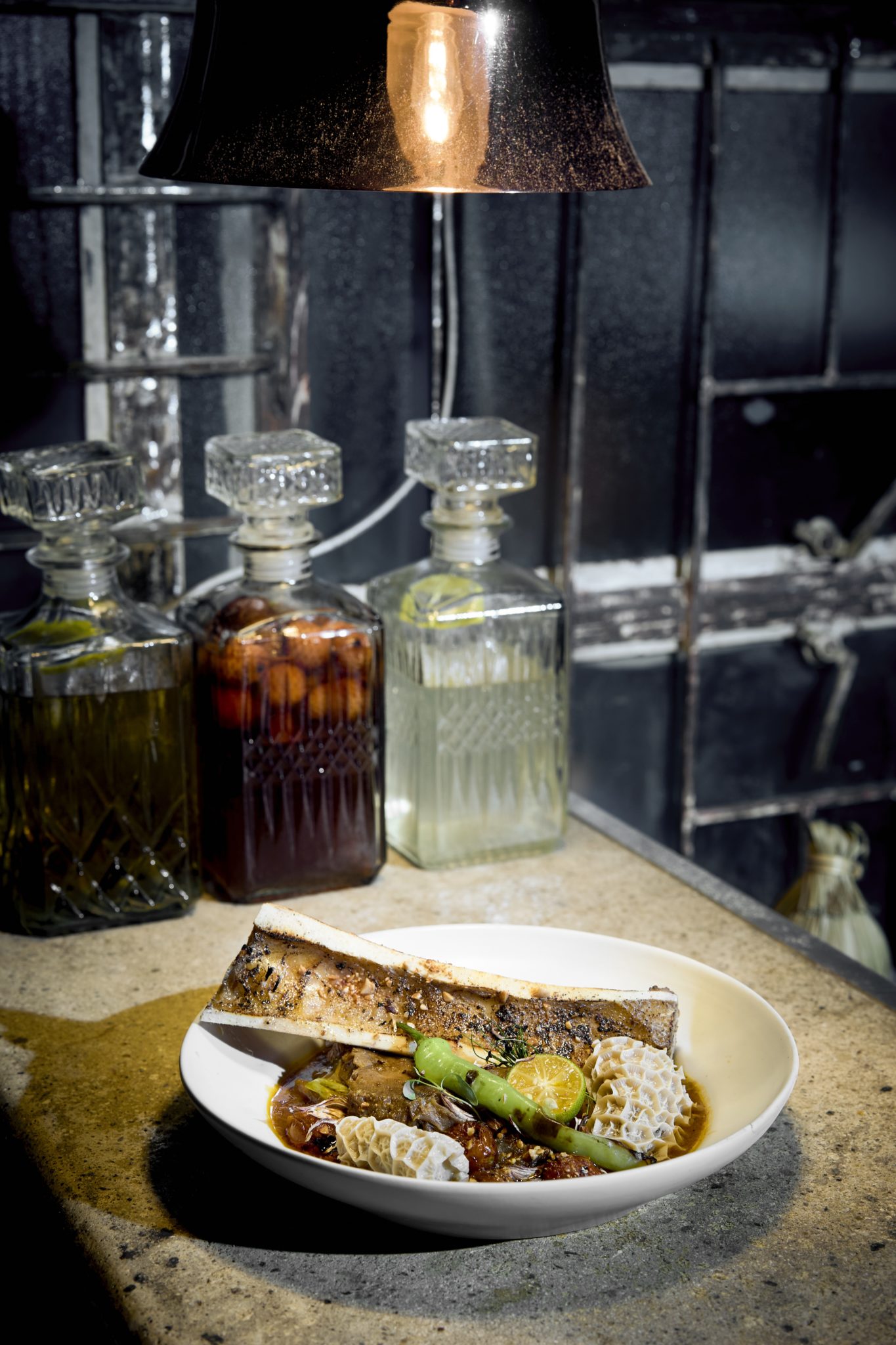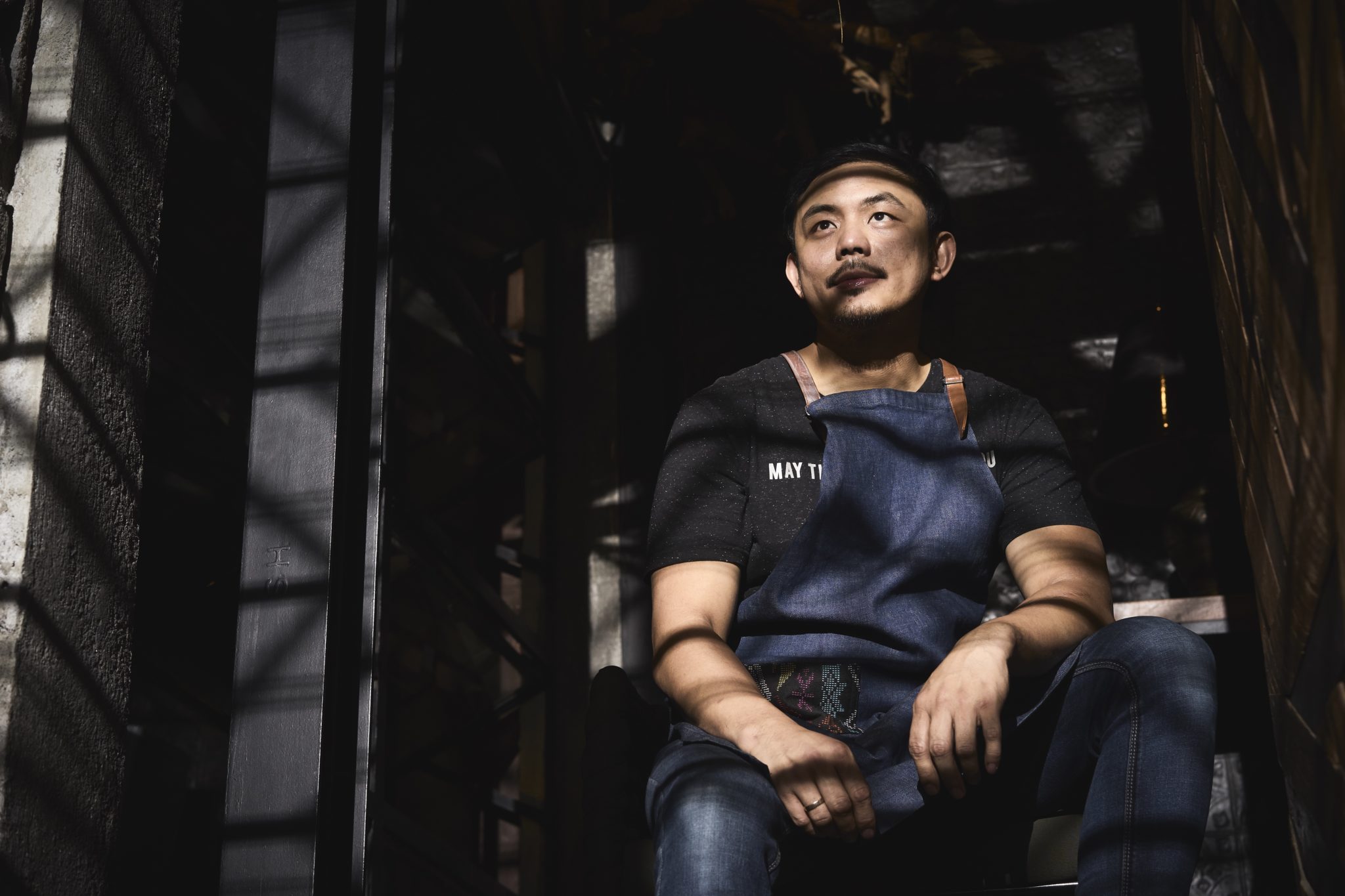A quick scan of Agimat’s menu reveals the ingenuity Niño Laus lends to Philippine cuisine: abuos, which are ant eggs from Ilocos, is served on roasted bone marrow; maliputo, a fish endemic to Taal Lake, is transformed into excellent pub food; and pinuneg, blood sausage made by indigenous tribes from the north, is paired with wild-foraged cocktails.
At Agimat Foraging Bar and Kitchen, the 37-year-old chef has mastered the art of gathering a mysterious cast of ingredients with nary a discernible plot line, places them in a centrifuge—the real device, not a metaphorical one—and spins a tale that makes people listen
Sourcing in the wild
“For me, it’s an adventure,” says Laus. “I love creating new things.”
His version of ceviche, Pogita at Malasugi, is a product of such passion. The plate features tender slices of cold-smoked blue marlin, pomelo slices bursting with sweet-tanginess, pickled seaweed and pako (fern), a sliver of fried espada (swordfish), and soft octopus tentacles. It’s finished with a calamansi nyebe—a vinaigrette featuring the local citrus with a hint of smoky tinapa, doused with liquid nitrogen to create an icy snow that melts the moment it hits your tongue.

The same passion brings Laus and his team to different provinces to gain inspiration and source ingredients. Together with mixologist Kalel Demetrio, the Agimat team visits local markets, small farms, and even lakes. He brings this wealth of knowledge and bagful of ingredients back to his playground that is Agimat. Here, his aim is to feature a hundred percent Filipino ingredients, both familiar and unusual.
“When coming up with a dish, I always draw inspiration from the main ingredient, through its sight, smell, texture, raw taste, habitat, and even its history, like how it was used by our ancestors,” says Niño Laus.
“When coming up with a dish, I always draw inspiration from the main ingredient, through its sight, smell, texture, raw taste, habitat, and even its history, like how it was used by our ancestors,” says Laus. “That’s why I enjoy foraging for these ingredients because I get to see the environment where it grows.”
Talking to farmers and townspeople allows Laus to understand ingredients at a deeper level; sometimes he even discovers their medicinal or spiritual purpose. Ultimately, he uncovers their story, prodding him to share the same to his guests via his work in the kitchen.
Finding the plot

The task of sourcing ingredients is challenging, but is one that Laus welcomes. Supply of most ingredients are limited or aren’t always available when its season ends; so Laus heads back to the drawing board, travels to the next province, and creates a new menu altogether. Another solution is to find ways to preserve the ingredient.
Sampinit, a sweet-sour local berry that resembles a raspberry, features prominently in Agimat’s moist chocolate cake. He turned the berry into a sorbet, which he keeps stock in the freezer. Other ingredients are transformed into ice cubes, vinaigrette, fermented goods, and pickled items.
Niño Laus’ current favorite in his arsenal is the centrifuge. It creates two products from one ingredient: a liquid and a purée.
To process all these elements, Laus employs a small arsenal that seems trivial and a passing novelty for some but are actually as essential to his creative process as a knife. He uses dehydrators on fruit and vegetables trimmings to minimize waste. He transforms them into unique sides and garnishes that add interesting visuals, scents, and textures to the dish. A rotary evaporator extracts delicate flavors the way a perfumer would distill scents.
“It produces a concentrated essence, and a few drops of this to our sauces and toppings make a big difference,” he says. On the opposite side of the kitchen counter, liquid nitrogen makes for a dramatic spectacle but also transforms sauces and vinaigrettes into a delicate icy dust. His current favorite is the centrifuge. It creates two products from one ingredient: a liquid and a purée. He is able to produce, for example, with sakurab—a type of local scallion—water that is colorless and transparent, and an onion purée. These and more are Laus’ supporting characters that help in completing his narrative.
Expanding playgrounds

His story didn’t begin with Agimat, however. Many—especially lovers—are more familiar with Laus’ debut restaurant, Ninyo Fusion Cuisine, in Quezon City. Opened in March 2006, the eponymously named spot dared to defy the floundering fad of fusion food and inject it with revitalized vigor. More than a decade later, the place has become a landmark in the Katipunan area and has played witness to many marriage proposals and anniversary celebrations.
Initially serving Japanese-French fusion cuisine—Japanese ingredients prepared using classical French techniques, a tribute to Laus’ love of Japanese cuisine and his first professional post in Century Park Hotel’s Unkai Japanese Restaurant in his early 20s, followed by his time working in the kitchen of French fine dining restaurant Parallel 45 by Humphrey Navarro—Laus now treats Ninyo as his laboratory.
“I play with different cuisines now; it could be Indian, Thai, whatever I want. Ninyo made my name,” he recalls. “It was such an honor building and making the concept of that restaurant.
“What makes a chef successful is creativity, originality, hard work, and passion,” he says. Is all this too much effort? Definitely, yes, he admits. “But it’s actually fun for me to create new things, and we get to travel and experience first-hand the ingredients available in the provinces we visit.”
It opened a lot of doors for me as a chef and as an entrepreneur because I really started it from scratch.” But, he admits, it wasn’t fully himself. “I was just thinking of what people wanted: It had to be cheap, to this budget, to this taste. I was still learning a lot of things, and I was a bit scared that it might not work out.” Experience gave him confidence, and with confidence came courage.
And slowly Filipino cuisine entered the picture. In June 2016, he opened what would be Agimat’s antecedent, Alamat Filipino Pub & Deli, featuring what Laus calls “pulutan cuisine”— elevated Filipino bar chow of skewers, tapas, and artisan sausages served alongside local cocktails, spirits, and draft beers.
With Alamat, Laus and his team began doing the basics of what later became their in-depth foraging exploits. “A bit of farm-to-table,” he describes the process. “We get rare ingredients, like longganisa from the north, or never-heard-of stuff, and we became successful with that concept.”
Brimming with potential
With every new local ingredient discovered and gathered, Laus becomes more experimental. Beef tongue from Batangas isn’t prepared into a creamy, mushroom-strewn lengua. He slices the tongue into cubes, salt-cures them for three days, and braises for another 72 hours. Then they’re skewered and slightly seared on the grill. It’s the ubiquitous barbecue reinvented.

And while some may wave off this kind of effort as just another passing trend to get local-loving, third wave-guzzling consumers through the doors, for Laus and his team, it’s a mission they intend to see through. Zero waste, in particular, is another mission important to him: “I have witnessed first-hand how our land gives us so much and it is our duty to take care of it in return.”
With three restaurants to his name and many successful consulting projects with other establishments in between, Laus relies not only on his youth for his energy and process. “What makes a chef successful is creativity, originality, hard work, and passion,” he says. Is all this too much effort? Definitely, yes, he admits. “But it’s actually fun for me to create new things, and we get to travel and experience first-hand the ingredients available in the provinces we visit.”
Originally published in F&B Report Vol. 15 No. 6





